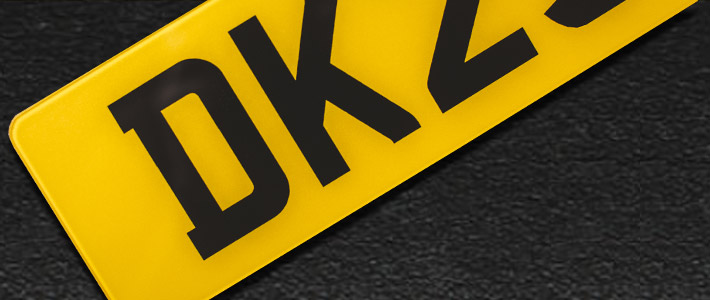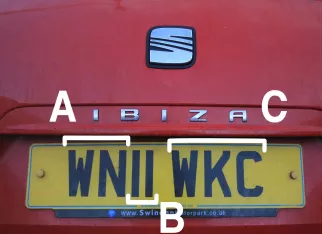A number plate distinguishes your car from others, as vehicle registration marks in the UK must be unique so that no two cars share the same sequence of numbers. However, many drivers feel compelled to add flair to their number plates, opting for private number plates. If you’ve purchased a private number plate, you should ask yourself whether or not you did so legally.
The government enforces strict guidelines on the lawful creation of private number plates, and all drivers should be aware of them.
Likely, you had good intentions when pursuing a private number plate. Still, drivers in the UK are responsible for confirming the legality of their private number plates. Failure to do so could land you in legal trouble, even cost you £1,000, or result in a failed MOT.
To help you better determine whether your number plate is legal, here are some common features that make number plates illegal in the UK.
Incorrect Spacing on Your Plates
Believe it or not, spacing matters and, if done incorrectly, could void the legality of your private plate. A review of your V5C logbook will offer you the specifics of spacing on your plates, but the logic behind this rule is that passersby and law enforcement cannot read an incorrectly spaced registration plate. Additionally, if the ANPR cameras (automatic number plate recognition) cannot read your license plate because of incorrect spacing, your number plate is illegal.
Wrong Font
The UK number plates used a specific font. A private number plate’s default font is “Charles Wright.” Most drivers and number plate providers agree with it being the standard font. The font enables improved letter and number visibility. If your number plate is using a different font other than Charles Wright, then your number plate is illegal.
Incorrect Flag
While the image of a flag on the number plate is not required, it is somewhat traditional. As a result, most drivers in the UK boast one on their number plates. But there is a misperception that having a legal flag to design the number plate also permits the use of alternative designs.
Authorities fine many drivers for displaying logos and other unauthorised images on their number plates. Examples of such imagery include Betty Boop, The Playboy Bunny, BMW and Mercedes Benz emblems, all of which are trademarked images that are not permitted to be used on official government number plates.
If you decide to add a flag on your number plate, it must be a valid flag approved by DVLA and must be appropriately positioned on the plate. Plates can be decorated with one of the following flags with identifying letters:
- Union flag (also known as the Union Jack)
- Cross of St George
- Cross of St Andrew – also known as the Saltire
- Red Dragon of Wales
You can have the following letters or national identifiers:
- UNITED KINGDOM, United Kingdom or the UK
- GREAT BRITAIN, Great Britain or GB
- CYMRU, Cymru, CYM or Cym
- ENGLAND, England, ENG, Eng
- SCOTLAND, Scotland, SCO or Sco
- WALES or Wales
Place the flags above the identifier. Neither the flag nor the lettering should be more than 50mm on the edge of the number plate.
Incorrect Number Plate Colour
In the Department of Transportation, the number plates on a car must adhere to these guidelines:
- Front: The front plate should display black characters on a white background.
- Back: The rear plate should show black characters on a yellow background.
If your number plate has other colours apart from the ones mentioned above, it is illegal due to how difficult it may be to read.
Plate Background Is Incorrect
UK number plates should have reflective backgrounds. This allows the characters on the plate to be emphasised and easily noticed. In addition, the background shouldn’t have any patterns. Plates Express manufactures acrylic number plates following parliament regulation BSau 145e. To meet MOT regulations, this little line of code must be visible on the bottom right corner of the front and rear number plates.
With the correct number plate background, drivers and road users can easily determine which way a car is facing, even in harsh weather. If your number plate does not meet these standards, it is illegal.
Wrong Bolt Placement
You must know the implications of mounting your number plate to your car with a bolt. A wrong bolt placement can affect how a number plate can be viewed, making it illegal. A letter or number in the number plate may appear differently from a distance if the bolt or the number plate is not positioned correctly. It wouldn’t be ideal if this caused your license plate to resemble another registered combination. Use matching background colours for the bolt and number plate, or use sturdy double-sided stickers to avoid making your number plate illegal.
Bottom Line
It’s fantastic to own a car, and it’s even more exciting if we can design and customise every aspect of it, down to the license plates. However, no matter how much we want to make our cars look better, we must remember that the number plate’s fundamental purpose is identification rather than design. Make sure your number plate is legal and complies with government standards before concentrating on designing it to improve your car’s appearance. To ensure that our number plate is legal, the best way is to be educated and well-informed about the laws and regulations.



